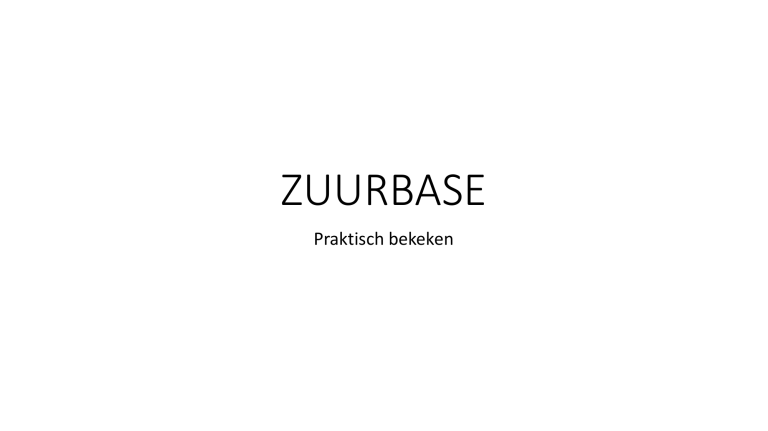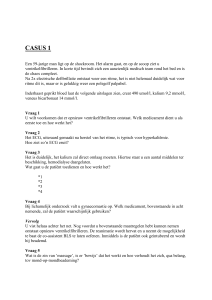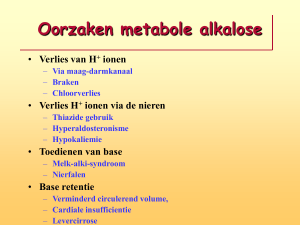
ZUURBASE
Praktisch bekeken
Bloedgasafwijkingen en Electrolytstoornissen
• Enerzijds handteken van ziekte (hulp in diagnose)
• Anderzijds mogelijk (urgente) pathologie op zich (? nood aan behandeling)
• BEHANDELING
• In eerste plaats etiologisch
• fct van Symptomen
• fct van acuut of chronisch
VUISTREGEL: chronisch bestaand is traag te corrigeren tenzij ernstige symptomen
• Electrolyten: HYPO- R/ exogeen toevoegen; HYPER- R/dilutie, verhoogde excretie (stop
intake); shift over membranen
• Hydrolyse reactie: H+ + HCO3- ↔ H2CO3 ↔ CO2 + H2O evenwicht
• H+ ifv metabole produktie, exogene toevoer, graad van excretie (renaal
proton, protonzuur, NH4+) en buffer capaciteit (EW , Hb, P…)
• CO2 ifv gasuitwisseling (ventilatie) long; cel productie
• NORMAALWAARDEN
•
•
•
•
•
pO2 80-100 mmHg(*0.1317 kPA)
pC02 35-45 mmHg (*0.1317 kPA)
pH 7.35-7.45
Bic 22-28 meq/l
Lactaat 1-1.8 mmol/l (* 8.9 mg%)
• ART vs. VENEUS: matig tot goede correlatie, zeker als trend en vaak ook
voldoende voor medische besliskunde; toekomst evt. mathematische
arterialisatie
• CAVE ANALYSEFOUTEN: luchtbel (↓ pCO2↑pH); celmetabolisme na 20’
(2u op ijs) (↓ pH↑pCO2 (↓ pO2); koorts (↓pH) ; bijmenging fysio (↓
pCO2↑pH)
• VRAAG 1: ? acidemie of alkalemie = toename of afname H+ in bloed
• VRAAG 2: ? Acidose of alkalose = aard van de primaire afwijking
(metabool HCO3- of respiratoir pC02)
• VRAAG 3: COMPENSATIE steeds in zelfde richting dan primaire afwijking
(meestal onvolledig, nooit overcompensatie)
GASUITWISSELING
• LONG: oxygenatie & ventilatie
• luchtwegen/AH centrum/FiO2
• alveolocapillaire membraan (diffusie ifv hogere nr lagere part P)
• perfusie Q
pO2
• drijvende kracht voor 02 binding op Hb en dus Sat02
(Hb dissoc curve sigmoidaal)
• fct van FiO2, diffusie; VQ matching
• niet opvangbaar door toename ventilatie gezien Hb saturatie maximum kent;
• impact van hypoventilatie met dalen pO2 door alveolaire accumulatie pCO2
• hypoxemie = dalen 02 inhoud arterieel bloed (obv oxygenatiestoornissen, anemie, CO…)
• hypoxie = weefsel 02 tekort waardoor aerobie niet behouden kan worden (obv hypoxemie of
ischemie) met productie lactaat (maat voor anaerobie en weefseldysoxie)
• TYPE 1 RESP. FALEN = gedaalde p02 tov FiO2 ondanks adequate ventilatie; met normale tot
verlaagde pCO2
• TYPE 2 RESP. FALEN = hypercapnie met normale tot gedaalde p02 (tov Fi02)
• Aa gradient: ≠ gemidd alveol. pO2 en art. pO2; maat VQ matching
• PalvO2 – PaO2 normaal < 20mmHG (iets hoger bij oudere of hogere FiO2)
• PalvO2 = (FiO2 * 713) – (1.2 * paCO2)
pCO2
• Vlotte diffusie over alveolocapp. membraan (groter verschil pCO2 alv-art)
• hierdoor vnl fct van Ventilatie (AH centrum, resp musculatuur..); minder
impact VQ matching (doordat opvangbaar via toename ventilatie)
• Primaire afwijkingen in pCO2 compensatie via H+ buffering (acuut 15’ maar
zwak) en renale compensatie (traag)
• Chronisch verhoogd pCO2 geeft desensitisatie CO2 receptoren met vnl.
hypoxic ventilatory drive (herkenbaar dr. verhoogd bicarbonaat)
pCO2
ACIDEMIE + HOOG CO2 = RESPIRATOIRE ACIDOSE
• Metabole compensatie voor elke ↑ 1mmHg
• acuut (weefselbuffer 0.1 mmol ↑ HCO3)
• chronisch (renaal ↑ 0.3-0.4 mmol ↑ HCO3 )
• ETIO: HYPOVENTILATIE (obstructie, spierzwakte, ARDS, dode ruimte ventilatie;
sepsis en glucoseoverbelasting…)
• Hypercapnie geeft cerebrale VD
ALKALEMIE + LAGE pCO2 = RESPIRATOIRE ALKALOSE
• Metabole compensatie voor elke ↓1mmHg
• acuut (weefselbuffer 0.2-0.3 mmol ↓ HCO3)
• chronisch (renaal ↓0.4-0.5 mmol ↓HCO3 )
• ETIO: central hyperventilatie, hypoxemie, salicylaat, xtc; leverfalen, te snelle
correctie metab acidose…
• Hypocapnie geeft cerebrale VC
Metabool
ACIDEMIE + LAAG BICARBONAAT = METABOLE ACIDOSE
• Respiratoire compensatie voor elke ↓1mmol resp. ↓1 – 1.2 mmHg pCO2
• ETIO: Bic verlies (GI, renaal, pancreas/gal); dalen protonexcretie (CNI); accum zuren (EW
afbraak, lactaat, ketonen, salicyl..)
• CAVE BIC R/ : risico toename intracellulaire acidose (door CO2 diffusie nr IC); shift Hb
dissocatie curve; inhibitie chemorecept en hyperventilatie; inhib catechol en negatief
inotroop; hyperNa; mogelijke toename CO2; niet causaal
(DUS enkel te overwegen als bv. <7.15 en symptomatisch, hyperkaliemie; verlies bij RTA of
intoxicaties salicyl…)
• BELANG IMPACT ACIDOSE OP ELECTROLYTEN: protonopname cel met uitstoten K+. Ook
toename P obv inhibitie IC glycolyse. Indien chronisch mogelijk onderliggend deficit (dr.
filtratie en verbruik)
Metabool
• ANION GAP: plasma ongeveer elektrisch neutraal
(NA + K) – (BIC + CL) = 10-18 (EW, P, Sulf..)
• wel drawbacks van oa labo interferentie bv hoge TG, invloed duur acidose etc
• Trend!; >15 is meestal abnormaal
• ETIO: ↓↑ Mg, K, Ca, EW, lithium; ureum, yGlob, P, Sulf, Ketozuren, lactaat, exogeen anionen
of kationen…
• Normale AG = HYPERCHLOREMISCH (al of niet met wijzigingen in K: GI verlies, RTA, nierinsuff,
ketoacidose…)
• BIC GAP (wijziging BIC = wijziging AG) zuivere metabole acidose
(< = geassocieerd alkalose; > is geassocieerd hyperCl metab acidose)
• OSM GAP = 2*NA + GLUC mmol/l (*18 voor mg%) + UR mmol/l (*2.8 voor mg%)
(verschillende formules in literatuur)
Metabool
ALKALEMIE + HOOG BICARBONAAT = METABOLE ALKALOSE
• Respiratoire compensatie voor elke ↑1mmol resp. ↑0.5 – 0.7 mmHg pCO2;
(plot eventueel op nomogram)
• ETIO VERLIES H+ of CL- ionen: (dD UCL > 10-20; U NA/K): braken, diarree,
maagvocht, diuretica, hypercapnie, hyperaldosteronisme, contractie
(hypovolemie en bic retentie)
GECOMBINEERD AFWIJKINGEN MET MOGELIJK normale pH
• ↑pCO2 ↓bic metabole acidose + resp alkalose
• ↑ bic ↓ pCO2 metabole alkalose + resp acidose
• Anion gap metabole acidose + metabole alkalose












